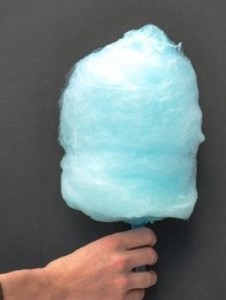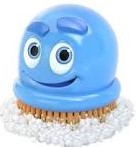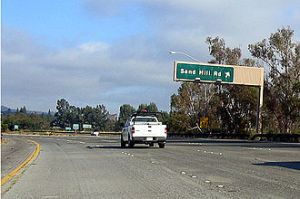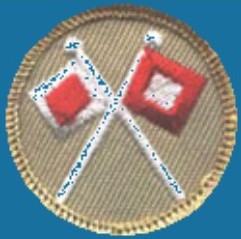March is looking decidedly mundane, if the first five days are any indication. I’m still recovering from my St. David’s Day festivities on the 1st (more about that here) so I suppose it’s all downhill until April. Even so, the laundry is washed and folded, the dishes are done and put away, and it’s grey and rainy outside, so what could I possibly have to talk about today? Why, dental floss, of course!
 Floss is even more mundane than my March to-date, yet there I stood, dwelling on the little nylon spool as I spun out another 18″ this morning. Snap off a length, wind tightly around the fingers, and commence the see-saw journey between and around each of your 28 pearlies (32 if you still have “wisdom”). It’s like you’re playing the smallest string instrument in the orchestra, and all you can contribute is the occasional enamel squeak.
Floss is even more mundane than my March to-date, yet there I stood, dwelling on the little nylon spool as I spun out another 18″ this morning. Snap off a length, wind tightly around the fingers, and commence the see-saw journey between and around each of your 28 pearlies (32 if you still have “wisdom”). It’s like you’re playing the smallest string instrument in the orchestra, and all you can contribute is the occasional enamel squeak.
 Why do I wonder about floss? So you don’t have to! On the list of all activities considered “morning routine” you’re probably way more invested in brushing your teeth, washing your face, or even throwing on deodorant. Flossing is the one where you stare into the mirror thinking, “Why can’t I text while I do this?”
Why do I wonder about floss? So you don’t have to! On the list of all activities considered “morning routine” you’re probably way more invested in brushing your teeth, washing your face, or even throwing on deodorant. Flossing is the one where you stare into the mirror thinking, “Why can’t I text while I do this?”
Floss. Looks weird and sounds weird, but it’s nothing more than a silky strand, at least in its original form. Then Johnson & Johnson came up with the nylon alternative – much easier to manufacture in large quantities – and today’s product was born. Waxed or unwaxed. Mono or multi-filament. Tape or picks. Whatever your weapon against plaque and gingivitis, we’re all participating in pretty much the same activity.

Candy floss is just another name for cotton candy. Meat floss is a dried, fluffy version of Chinese pork (appropriately named “yuk”). Floss is also an embroidery term, a town and river in Germany, and an awkward dance move where the arms swing rapidly behind and in front of the body. But none of those are the first to come to mind when I say “floss”, right?
Here’s what I want to know. Why hasn’t someone made flossing more convenient in the 125+ years we’ve all been doing it? Seriously, I’m picturing those little scrubbing bubbles zooming all over the porcelain of your bathtub, leaving it squeaky clean. Couldn’t we have a similar product we swish around in our mouths? It’d be like a dose of Pop Rocks, where you have a few moments of crackling and hissing in your mouth, followed by a rinse and spit. Bye-bye plaque, no nylon required.
 I didn’t manage to “habit” flossing until about age 25. Before that I was too busy accumulating cavities. I’m still trying to perfect the see-saw technique after all these years. Scrape each tooth instead of just snapping up and down between them. Rewind the floss a few times on your fingers so you’re not using the same inches on all of your teeth. Floss before you brush. Finally – the tough one for me – make flossing part of your evening routine, not your morning.
I didn’t manage to “habit” flossing until about age 25. Before that I was too busy accumulating cavities. I’m still trying to perfect the see-saw technique after all these years. Scrape each tooth instead of just snapping up and down between them. Rewind the floss a few times on your fingers so you’re not using the same inches on all of your teeth. Floss before you brush. Finally – the tough one for me – make flossing part of your evening routine, not your morning.

Here’s the math (because I just have to know these things). If I’ve really flossed every day since my mid-twenties, I’ve used over four miles of the stuff (or 20,000+ ft). At 18″ per cleaning that’s countless little lengths. But here’s another way to look at it. A typical dispenser of floss contains 55 yards, meaning in almost forty years I’ve only purchased 128. You could probably fit those dispensers into a single shoebox. And at $1.29 per dispenser, the whole box only sets you back $165.
 Until someone invents those edible scrubbing bubbles, I’ll keep filling up shoeboxes with empty floss dispensers. My product is Reach; yours might be something more exotic like “Grin Fine Flosspyx” or “Boca Ela Mint”. No matter how fancy the name, it’s just a piece of nylon string. And until my March gets more exciting you’ll find me in front of the mirror each morning (er, evening), playing my little string instrument.
Until someone invents those edible scrubbing bubbles, I’ll keep filling up shoeboxes with empty floss dispensers. My product is Reach; yours might be something more exotic like “Grin Fine Flosspyx” or “Boca Ela Mint”. No matter how fancy the name, it’s just a piece of nylon string. And until my March gets more exciting you’ll find me in front of the mirror each morning (er, evening), playing my little string instrument.
Some content sourced from Wikipedia, “the free encyclopedia”.





